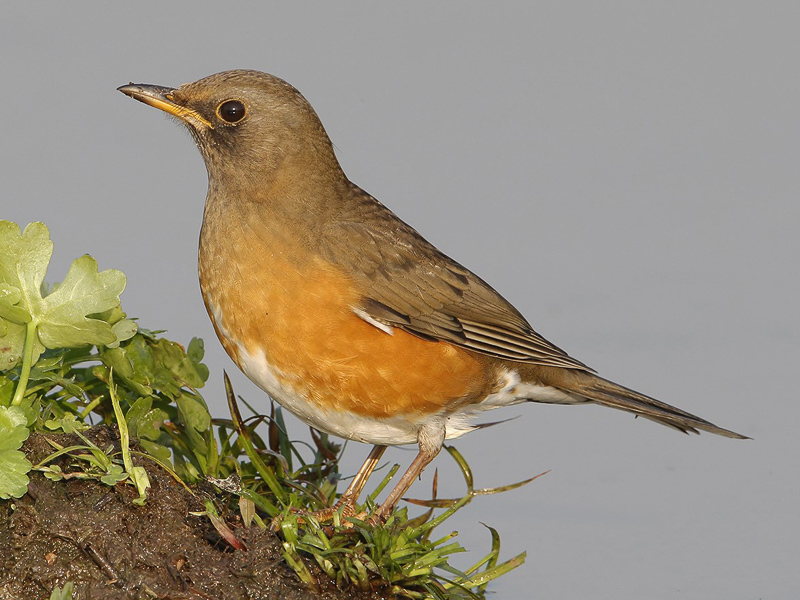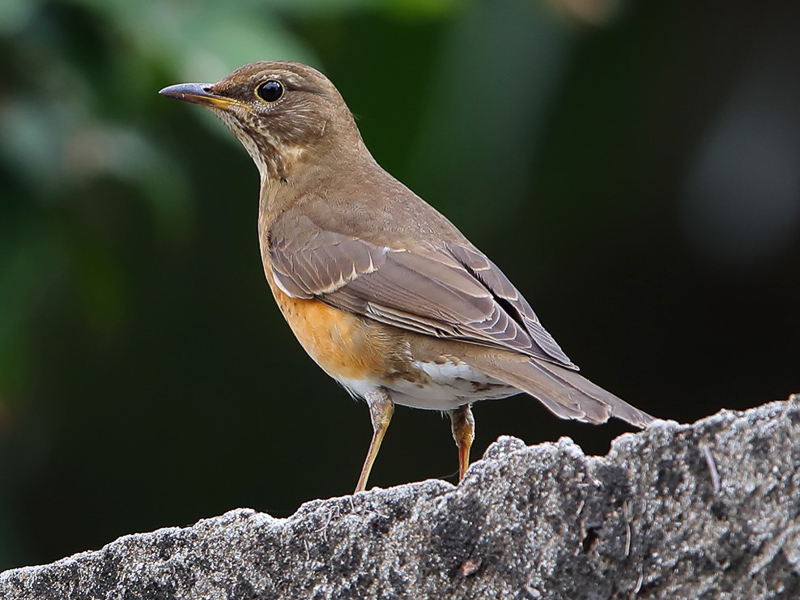Brown-headed Thrush Turdus chrysolaus 赤胸鶇
Category I. Scarce winter visitor to wooded areas.
IDENTIFICATION

Nov. 2019, Guy Miller. Adult male.
23-24 cm. Rather uniform above but usually extensively orange on the flanks. Adult males, rare in HK, have dark greyish face and throat, brownish-olive upperparts and an extensive yellow base to the bill.

Jan. 2014, Martin Hale. Adult female.
Adult female has uniform olive-brown head and upperparts with paler throat streaked dark, orange flanks slightly duller and less extensive than on the male. May have a faint, diffuse supercilium.

Dec. 2018, Michelle and Peter Wong. First-winter.
First-years have pale flecking on the face, darkly streaked sides to the throat, pale tips to the greater coverts in fresh plumage and are duller above.
VOCALISATIONS
The call uttered either in flight or when perched falls sharply in pitch, is slightly shorter in duration and terminates rather abruptly in comparison to the commonly-occurring Grey-backed and Japanese Thrush. It is most similar to the call of Pale Thrush.
DISTRIBUTION AND HABITAT PREFERENCE
Widespread in woodland through much of HK though at very low densities.
OCCURRENCE
One of the more infrequently regularly-recorded Turdus thrushes in HK, Brown-headed Thrush is a scarce winter visitor from the third week of November to the first week of April, with very few records outside this period (Figure 1). Extreme dates are 16 November 2009 and 22 April 2020, with the highest count being four at Ho Man Tin on 15 December 2015 and on Po Toi on 18 December 2018.
Most records occur in the second half of November and December, indicating some passage occurs. The number of wintering birds appears stable from the beginning of January to the middle of March, and an increase in numbers after then indicates spring passage.
Swinhoe (1861) recorded Brown-headed Thrush in February and March; Vaughan and Jones (1913) stated it was an accidental winter visitor until at least 6 April. There were then no records until the establishment of the HKBWS in 1958.
BEHAVIOUR, FORAGING & DIET
Typical of Turdus thrushes, seen foraging among leaf litter on forest floor and in fruiting trees (Schefflera heptaphylla and Syzgium hancei).
RANGE & SYSTEMATICS
Breeds from Sakhalin the Kuril Islands south to Honshu, Japan, winters from southern Japan south through the Ryukyus to Taiwan, coastal mainland China, Hainan and north Philippines. In China a migrant on the east and winter visitor to the southeast (Liu and Chen 2020).
Two subspecies are recognised. The nominate breeds in north and central Japan and is considered to winter in south Japan, southeast China (including HK and Taiwan) and the north Philippines. T. c. orii breeds in Sakhalin and the Kurile Islands, and winters in Japan (Collar 2020).
CONSERVATION STATUS
IUCN: Least Concern. Population trend unknown.
Figure 1.

Collar, N. (2020). Brown-headed Thrush (Turdus chrysolaus), version 1.0. In Birds of the World (J. del Hoyo, A. Elliott, J. Sargatal, D. A. Christie, and E. de Juana, Editors). Cornell Lab of Ornithology, Ithaca, NY, USA. https://doi.org/10.2173/bow.brhthr1.01
Liu, Y. and Y. H. Chen (eds) (2020). The CNG Field Guide to the Birds of China (in Chinese). Hunan Science and Technology Publication House, Changsha.
Swinhoe, R. (1861). Notes on the ornithology of Hong Kong, Macao and Canton, made during the latter end of February, March, April and the beginning of May 1860. Ibis 1861: 23-57.
Vaughan, R. E. and K. H. Jones (1913). The birds of Hong Kong, Macao and the West River or Si Kiang in South-East China, with special reference to their nidification and seasonal movements. Ibis 1913: 17-76, 163-201, 351-384.

